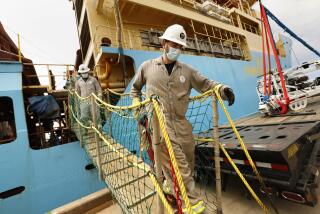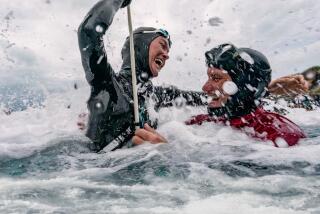Into the Blue : Free-Diving Hunters Hold Their Breath in Hopes of Spearing a Big Fish
- Share via
As free-diver Don-Paul Gaboury of Costa Mesa descended through the blue Mexican waters, no bubbles or noise from cumbersome scuba equipment followed him down to frighten off his prey, big wahoo.
He leveled off at 40 feet and waited, motionless.
A silvery sphere of thousands of small fish came at Gaboury, and he neatly glided through it. Then, suddenly, it vaporized, just disappeared, spooked by a predator.
The hunter went on automatic pilot. He kicked his two giant fins for propulsion, then raised his spear gun. Less than 20 feet away, he saw the fusiform shape coming at him, and as it turned, the wahoo exposed its unmistakable striped flank and blazing iridescent colors.
Gaboury aimed and struck the wahoo with a perfect shot.
“I was thinking, ‘This is my food, and if I land this fish I’ll have 70 pounds of wahoo all summer,’ ” Gaboury later said exuberantly.
To be precise, 74 1/2 pounds, which at the time was a possible world record, though it was surpassed by a 78-pounder speared in Hawaii in the same month. (That record was toppled this month in Mexico when a diver speared an 84-pound wahoo.)
Armed with only a snorkel, mask, fins and spear gun, elite divers such as Gaboury rely on two lungs full of air to take them into the depths in search of world-class game fish.
For more than two decades, Gaboury, a 44-year-old metal fabricator, has spent thousands of hours free-diving, which he readily admits is his passion. He is a former president of the Long Beach Neptunes, one of the preeminent free-diving groups in the state, if not the world.
As a Neptunes member, Gaboury belongs to what fellow diver Terry Maas calls the world’s best. “Don is a great diver to be with,” Maas said.
Maas, 52, of Ventura, has 38 years’ experience spearfishing in the world’s oceans and holds two world records: a 398-pound bluefin tuna and a 255-pound yellowfin, both speared in shark-infested waters off Mexico.
Maas has plunged into cyberspace by putting his book, “Bluewater Hunting and Freediving,” and video, “Blue Water Hunters,” available at his Web page, https://www.freediver.net/ocean/bluewater.html
How many undersea hunters prefer leaving scuba tanks at home is unknown. The Santa Ana-based Professional Assn. of Diving Instructors, or PADI, has no statistics on free-divers, but conservatively estimates there are 4 million scuba enthusiasts in the United States and about 6 million worldwide.
Bryce Ogle, 27, of the Aquatic Center in Newport Beach, said that while lots of people enjoy diving, it takes a special breed to enter the ocean relying only on a deep breath.
“I think there’s more sport in it,” Ogle said, “and it’s more challenging and rewarding at the same time.”
Nelson Dooley, president of the Fathomiers, a Southern California dive club, was scuba certified in 1968. But like many others, he switched to free-diving because he didn’t like taking all the equipment such as air tanks, gauges and buoyancy compensators.
“Underwater, you’re not encumbered with equipment, even though you are limited to your breath hold. You’re much more streamlined in the water,” Dooley said. “Kind of like a nuclear attack sub running silent. But some days we never get the chance to pull the trigger of the spear gun. I personally call those days ‘my National Geographic moments.’ ”
Experienced free-divers can remain submerged at depths of 40 feet and more for an average of one to two minutes. Some can stay longer, especially if they’ve speared a giant fish, Gaboury said.
Yet this challenging sport comes with risks.
While free-divers relish the ability to “run silent”--improving their chances to sneak up on game fish--it also increases the chance of shallow water blackout, when the diver no longer feels a need to breathe but his lungs run out of air.
In 1992, Kent McIntyre, a 30-year-old chiropractor from Rancho Santa Margarita, is believed to have drowned, possibly from a blackout, after spearing a 100- to 125-pound grouper during a dive off La Paz in Baja California.
Last spring, Bill Kroll, Neptunes’ president, drowned while diving off Santa Catalina Island. Kroll may have been experimenting with a technique in which the diver exhales all his air on the surface, allowing him to sink and glide down in ultimate stealth mode.
“These blue-water hunters are obviously pushing the envelope,” said Laguna Beach Lifeguard Lt. Scott Diederich, “and occasionally land on the wrong side and lose their life.”
Locally, 16-year-old Christopher William Cvengros of San Juan Capistrano drowned in December while snorkeling off Laguna Beach.
There are other dangers.
Maas’ world-record bluefin tuna, caught off Guadalupe Island in Mexican waters, is also the location where Al Schneppershoff, one of the most revered blue-water divers in the 1960s and early ‘70s, died after an attack by a great white shark in 1973.
“We’re all A-type personalities, and have a lot of water time,” Gaboury said. “If you follow any extreme sport it catches up to you. The Neptunes push the limits.”
To prepare, divers like Maas and Gaboury have intense physical training exercises. Gaboury doesn’t smoke, hardly drinks, and jogs and lift weights. He thinks nothing of getting on a stair climber and holding his breath, “till you pass out.”
Pushing the envelope is the norm among top divers. Free-divers enjoy diving alone, even at night, rather than with other hunters, which goes against the grain of scuba’s buddy system.
“Honestly, they throw caution to the wind,” Diederich said. “They don’t dive with buddies and you should dive with buddies even while just swimming in the ocean. It may cut your chances of great fishing but it increases your chances of survival.”
If there is an axiom in free-diving, it isn’t about safety. It’s making sure the fish gets on the boat, Gaboury said.
“Shooting the fish is one thing,” Gaboury said, “but if you don’t claim your catch soon, it can become shark food.”
Gaboury recalled an encounter with a 400- to 500-pound bull shark in the Sea of Cortez during the same dive he bagged the big wahoo. The shark was curious about the wetsuited intruder.
“It had most of its weight up near its shoulders, it was big,” he said.
He carried a shark deterrent, a 12-gauge power head that attaches to the spear’s tip and can be used for overly aggressive sharks or other predators, including large barracuda.
As the shark closed in, Gaboury loaded the tip to his spear, making slow, deliberate gestures. “You don’t want to initiate flight mode,” he said. “[The shark] came in tight, within 5 feet.”
Gaboury aimed his spear at the shark but hesitated.
“I’m gonna let him circle one more time,” Gaboury remembers thinking, “and then I’m going to pull the trigger.”
But as suddenly as it appeared, the shark inexplicably swam in a wider circle, its curiosity apparently sated. It left the area.
Gaboury continued spearfishing and swam through the “bait ball” of tiny fish and shot the wahoo. The bull shark was history. Or so he believed.
“I was sure that I stoned the fish,” Gaboury said, “and I started surfacing when my friend the bull shark reappeared and opened his big mouth.”
Gaboury watched the drama through his face mask as the fish struggled, hooked by the diver’s spear, which was tied to 100 feet of line. The shark’s only treasure was a lobe of the wahoo’s tail.
“It was incredible,” Gaboury said. “Here I thought the wahoo was dead, but it saw that big shark coming in and it flexed its powerful muscles and streaked off 500 feet.”
Gaboury ordered the boat to move in, and when the crew was pulling him aboard, the wahoo was dead, minus the fin lobe, and the shark was nowhere to be found.
(BEGIN TEXT OF INFOBOX / INFOGRAPHIC)
Blue-Water Hunting
Holding their breath, they dive deep into the ocean, hunting big fish--up to several hundred pounds. Armed with spear guns and no artificial breathing apparatus, blue-water hunters brave numerous dangers for one good shot at a large game fish.
Equipping Themselves
Wet suit: Divers spend many hours in the water, so a good wetsuit to insulate them is especially important. They are often custom-made.
Fins: Extra-long, 1-meter fins are used for more power. Made of a multi-fiber composite, stiff fins can be used for deep dives, and more flexible ones make long swims less tiring.
****
Snorkel Mask
Weight belt: Common type has 1-inch tubes of lead threaded through a nylon belt. Amount of weight needed depends on buoyancy of wetsuit and diver.
Knife: Used to free diver from tangled line or kelp. Divers often carry two in case they drop one.
Buoys: Can be used to alert boats of diver’s presence or to track speared fish.
****
The Spear Gun
Local hunters use spear guns powered by thick rubber bands. World-class hunter Don-Paul Gaboury, from Costa Mesa, uses a handmade wooden gun. A look at how his gun works:
Material: Mahogany laminate, 50 inches long
Rubber slings: Large rubber bands create tension. When tension is released by pulling trigger, spear shaft is propelled through water. Greatest accuracy is at 10 feet from target.
Trigger mechanism: Releases tension to propel spear.
Shooting line: Thick line (3 to 4 times length of gun) is attached to spear shaft and connected to a reel of 400-pound monofilament trail line so diver can fight fish from surface if necessary.
****
Spear Tips
The tip a diver uses depends on the type of fish being hunted. These two are used for sea bass, yellowtail and tuna:
Slip tip: Used for large fish with soft skin. Tip is attached to spear shaft by aircraft cable. It holds fish by penetrating and toggling, causing less damage to the meat.
Fixed tip: This tip is less complicated to use. However, it does not detach from shaft, meaning that fighting fish are more likely to destroy meat and bend spear shaft.
****
SPORT FISH
Local pelagic (open water) game fish include:
White Sea Bass
(Sea trout)
Range: Baja California to Alaska
Habitat: Shallow to deep water
Size: Up to 5 feet; over 100 pounds
*
Yellowtail
Range: Chile to southern Washington
Habitat: Open water and near kelp
Size: Up to 5 feet; 80 pounds
*
Bluefin Tuna
Range: Peru to Alaska
Habitat: Surface of open ocean
Size: Up to 10 feet; 1,400 pounds
Note: Yellowfin tuna also found locally some years
****
AVOIDING DANGER
Top threats to local blue-water hunters:
Boats and jet skiers: Can injure or kill divers when not aware of their presence.
Own trail line: Virtually invisible, it can get wrapped around diver’s legs.
Shallow water blackout: Diver runs out of breath when trying to surface--sometimes with no warning--and loses consciousness.
Speared fish: Large fish still attached to divers can tangle them in line or around rocks or kelp.
Sharks: Great whites, blue sharks and others may behave aggressively toward divers, especially if there is blood or wounded fish in the water.
****
HUNTING FOR FISH
1. Locating bait fish and preparing: To find game fish, a diver must locate their bait by boat. Local bait includes anchovies, top smelt and Pacific mackerel. Where there is surface bait, many birds often are feeding. Once near the area, the diver first needs to relax the heart rate and swim for at least five minutes to acclimate.
2. Exploring the area: After diving to the depth of the bait, a diver suspends and observes the area. After perhaps two minutes--depending on the individual--the diver surfaces and recovers for a few minutes.
3. Spotting game fish: Diver continues cycle of diving and surfacing. If bait fish “explode” in all directions, diver looks around to see what has scared them. If it is a tuna, the diver avoids swimming toward the fish, which would startle it. Instead the diver swims parallel to the fish and hopes to intersect its path.
4. Taking a shot: If able to get within 10 feet, the diver may be able to take a shot. The target is vital spots--head or spine--which can instantly kill the fish. Large fish often pull the diver, which necessitates the use of a buoy connected to the line to track its path.
5. Recovering the catch: If fish dies instantly, the diver simply swims over and carries it up to the surface. If not, the diver may need to fight the fish from the surface. After it tires, the diver can dive down and tow it up by the gill plate.
****
HOT SPOTS
Local blue-water hunters frequent these locations:
Catalina Island
San Clemente Island
Cortez Bank
****
DIVER GLOSSARY
Snorkelers and skin-divers: Stay at shallow depths, with no self-contained breathing apparatus
Free-divers: Skin-divers who dive to deeper depths than snorkelers, down to 100 feet for as long as two minutes
Blue-water hunters: Free-divers who hunt for open-water game fish
Sources: Don-Paul Gaboury, Long Beach Neptunes; “The Audubon Society Field Guide to North American Fishes” and the Internet
Researched by KRIS ONUIGBO AND DAVID PUCKETT / Los Angeles Times
More to Read
Sign up for Essential California
The most important California stories and recommendations in your inbox every morning.
You may occasionally receive promotional content from the Los Angeles Times.










